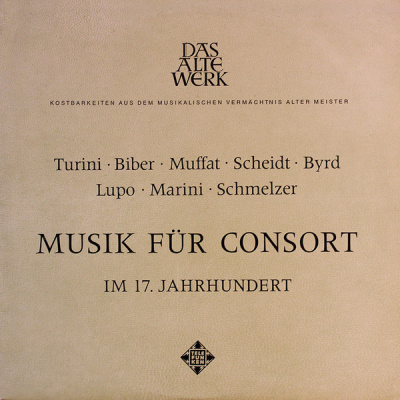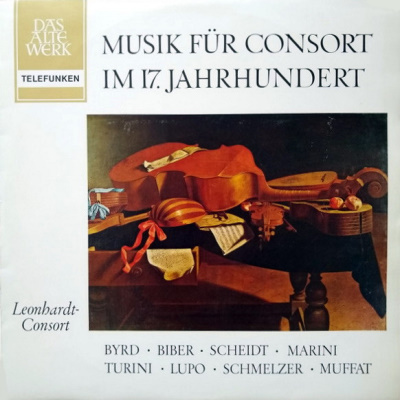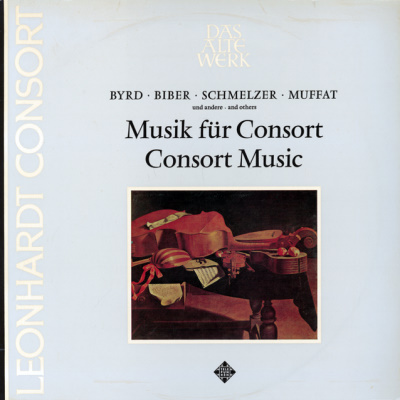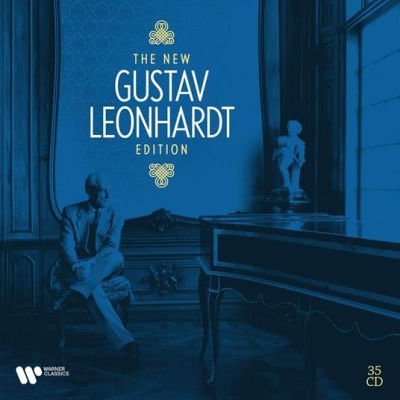 |
|
1 LP -
SAWT 9461-B - (p) 1964
|
 |
| 1 LP -
SAWT 9461-B - (p) 1964 |
 |
| 1 LP -
6.41063 AS (SAWT 9461-B) - (p) 1964 |
 |
| 35 CDs -
0190296467714 - (c) 2022 |
|
| MUSIK FÜR
CONSORT IM 17. JAHRHUNDERT |
|
|
|
|
|
|
|
| Francesco TURINI
(c.1589-1656) |
Sonata
in a (1621) - (a doi Violini e Basso
Secondo Tuono) - aus "Madrigali... con
alcune Sonate, Libro Primo" |
|
3' 35" |
A1 |
| Heinrich Ignaz Franz
BIBER (1644-1704)
|
Sonata
IV 2 Violinen, 2 Bratschen, Continuo
- aus "Fidicinium sacro-profanus... (1683)
|
|
6' 40" |
A2
|
|
- Alla breve · (Presto) ·
Adagio · Alla breve
|
|
|
|
|
Sonata
V 2 Violinen, 2 Bratschen, Continuo
- aus "Fidicinium sacro-profanus... (1683)
|
|
3' 40" |
A3 |
|
- Allegro
· Grave · (Più presto) · Allegro
|
|
|
|
| Georg MUFFAT (1653-1704) |
Sonata
II g-moll 2 Violinen, Bratschen,
Continuo - aus "Harmonischer
Damkeserweis"... Salzburg, 1682 |
|
12' 50" |
A4 |
|
- I.
Sonata: Grave · Allegro · Grave ·
Forte e allegro · Grave
|
|
|
|
|
- II.
Aria: Grave-Sarabanda · Grave · Borea |
|
|
|
| Samuel SCHEIDT (1587-1654) |
Pavane
in a (1621) 2 Violinen, Bratsche,
Cont. (a 4 voc.) |
|
5' 22" |
B1 |
| William BYRD (1543-1623) |
In
Nomine (Quintett Nr. 3) 2 Violinen,
2 Bratschen, Violoncello
|
|
3' 15" |
B2 |
| Thomas LUPO (gest. 1660?) |
Fantasia
2 Violinen, 2 Bratschen, Violoncello |
|
3' 40" |
B3 |
| Biagio MARINI (1597-1665) |
Balletto
secondo (1655) 2 Violinen, Bratsche,
Cont. |
|
5' 12" |
B4 |
|
- Entrata
(Grave) · Balletto (Allegro) · Gagliarda
· Corrente · Pretirata |
|
|
|
| Johann Heinrich
SCHMELZER (c.1623-1680) |
Sonata
VII 2 Violinen, 2 Bratschen, Cont. -
aus "Concentus, 1662"
|
|
3' 43" |
B5 |
|
Sonata
IX 2 Violinen, 2 Bratschen,
Cont. - aus "Concentus, 1662" |
|
4' 07" |
B6 |
|
|
|
|
|
DAS LEONHARDT-CONSORT
- Marie Leonhardt, Violine (Jacob
Stainer, 1676)
- Antoinette van den Hombergh, Violine
(Klotz, 18, Jahrhendert)
- Wim ten Have, Viola (Giovanni Tononi,
17. Jahrh.)
- Lodewijk de Boer, Viola (deutsch, 18.
Jahrhundert)
- Dijck Koster, Violoncello (Giovanni
Battista [II] Guadagnini, 1749
- Gustav Leonhardt, Cembalo (Martin
Skowroneck, Bremen 1950 nach einem
italienischen Modell des 17. Jahrhunderts
[zwei 8']) und Orgel (Klaus Becker,
Kupfermühle 1961)
Gustav LEONHARDT, Leitung
|
|
|
|
|
|
Luogo
e data di registrazione |
|
(luogo di
registrazione non indicato) - 1964
|
|
|
Registrazione:
live / studio |
|
studio |
|
|
Producer |
|
Wolf Erichson
|
|
|
Prima Edizione
LP |
|
Telefunken "Das Alte
Werk" | SAWT 9461-B | 1 LP -
durata 48' 01" | (p) 1964 | ANA
Telefunken "Das Alte Werk" | SAWT
9461-B | 1 LP - durata 48' 01" |
(p) 1964 | ANA | Riedizione
Telefunken "Das Alte Werk" |
6.41063 AS (SAWT 9461-B | 1 LP -
durata 48' 01" | (p) 1964 | ANA |
Riedizione
|
|
|
Edizione CD |
|
Warner Classics
"The New Gustav Leonhardt
Edition" | 01902964467714 | 35
CDs | (c) 2022 | ADD/DDD
- CD 29: Lupo
- CD 31: Biber, Muffat, Scheidt,
Schmelzer
- CD 35: Turini, Marini
- il brano di William Byrd non è
stato ripubblicato in compact
disc.
|
|
|
Cover
|
|
E. Baschenis:
"Musikinstrumente".
|
|
|
Note |
|
-
|
|
|
|
|
|
The theory
that the instrumental style
did not free itself from
vocal music until the
seventeenth century is only
confirmed to a limited
degree by the facts. One
could indeed say that, in
the course of the
seventeenth century,
instrumental style adapted
itself more and more to the
various categories of
instruments, and that the
idioms of the instruments
became an increasingly
important factor, being
taken more and more into
consideration.
In general, the nature of
the instrumentation was
always specified by the
composer in the 17th
century. In addition to the
keyboard instruments, it is
the stringed instruments
which one can describe as
the “star instruments” of
that century. We find
virtuoso literature for the
gamba and for the violin
(Falconiero, Ucellini,
Simpson, Schmelzer, Walther,
Biber, Marais, Kühnel,
Schenk, Corelli), and it is
no mere accident that this
century also produced such
famous instrument makers as
Amati, Jaye, Maggini,
Stradivari, Stainer, Tielke.
In the ancient gamba family
the bass-tenor viol
gradually seperated itself
from the others on account
of its suitability for solo
purposes; on the other hand
the violin, a true solo
instrument, was only just
gradually beginning to
gather its family together,
although without giving up
its own partiality to solo
work. In the literature
produced for string
ensembles, no great
distinction was made at
first between the viols (da
gamba) and the violins (da
braccio) in England and
Germany, even though the
viol ensembles were given
preference well into the
century in England. Italy,
on the other hand, hardly
cultivated the gamba at all
in the 17th century, and
string ensembles there were
almost exclusively composed
of instruments of the violin
family.
The gambas, with their
frets, long measurements and
thin strings, are
predestined for a clear,
well blended ensemble sound,
or else for virtuoso solo
literature that exploits to
the full the instruments’
possibilities for choral
playing - created by their
frets and their system of
tuning. The violin, without
frets, with shorter
dimensions and greater
tension in the strings
(especially in Italy), is
predestined for presenting
itself with brilliance in a
solo role; ensemble pieces
in 4-6 parts are not
conceived polyphonically in
the first place, but the
upper parts usually
predominate. We also find
works written after the
middle of the century in
which, for example, one or
two violins are
“accompanied” by two or
three alto and bass viols in
addition to the continuo.
In our recording instruments
of the “braccio” family are
used: 2 violins, 2 violas
and ‘cello (five-part
writing was very popular in
the 17th century; not until
around 1700 did four parts
become the norm). The
instruments, German and
Italian from the 17th and
18th century, ar all in
so-called baroque
dimensions, some having
remained unaltered, others
having been restored to
their original form. For
reasons of tone - on no
account historically
unquestinable - a pitch has
been chosen that lies one
semitone below normal. The
intonation will also strike
the listener as unusual, for
the Leonhardt Consort has
been endeavouring for years
to accustom its ear - and
that of the listener - to a
non-equal temperament.
The works played on this
disc allow us a glimpse into
the abundance of available
literature, and also a
survey of the various styles
that were cultivated in
various European countries
over a period of about 80
years. The “modern” Sonata
by Turini is contrasted with
works by the Englishman Lupo
and by Scheidt that were
written about the same time.
Then there are the
compositions of the three
violin virtuosi: Marini with
his unproblematical
extravagances, Schmelzer
with his affected (but also
convincing) sweetness and
excitement and Biber with
his intense compactness. And
last of all figures the
great Muffat who, through
his training and his gifts,
achieves a perfect synthesis
of French control and
Italian fantasy.
Francesco Turini was
Court Organist to the
Emperor Rudolf II in Prague,
and from 1624 onward
Cathedral Organist in
Brescia. The greater part of
his creative activities was
devoted to secular and
sacred vocal music, while
his Trio Sonatas are among
the earliest existing
examples in this category.
Heinrich Ignaz Franz
Biber, the greatest
violin virtuoso and
instrumental composer of the
German speaking region in
the 17th century, rose from
being a violinist at the
archepiscopal courts of
Olmütz and Kremsier to the
position of Court Conductor
and Lord High Steward to the
Archbishop of Salzburg,
being elevated to the
nobility in 1690. His fame
quickly became legendary. In
his works he has blended
Italian tradition,
folk-music freshness and
variety of invention and
improvisatory freedom of
form, in a manner that looks
far into the future, its
effect still being felt
right down to Mozart.
Georg Muffat,
Frenchman by birth of
english decent worked in
Paris, Alsace, Vienna,
Prague and Salzburg. His
works rooted in Lully's
world of forms, combine
french rhythms, dance-forms
and art of the suite,
Italian concerto technique,
German fugal technique and
melodic fervency.
Samuel Scheidt was a
pupil of the Netherlands
“organist-maker” J. P.
Sweelinck, became Court
Organist and later Court
Conductor to the Archbishop
of Magdeburg and was for a
time Municipal Director of
Music in Halle. Together
with Schütz and Schein he is
one of the three “great S's”
of German music of his time.
His greatness reveals itself
to us today above all in the
disciplined blending of the
highest art of contrapuntal
and combinatory part-writing
with song-like fulness and
freshness of melody.
William Byrd,
acclaimed by his
contemporaries as “Phoenix”
and “Father of Music”, was
not only the greatest
English composer of his
time, but one of the
greatest Renaissance
musicians altogether. In
spite of his unexciting life
- withdrawn from the world,
uneventful and devoted only
to music, his fame was
great. His many instrumental
compositions display an
extraordinary imagination
for sound and an
inexhaustible wealth of
formal and melodic ideas.
Thomas Lupo, the
second to bear this name,
was member of a family of
Italian musicians. Being a
player of the tenor viol in
the Court Orchestra in
England, he specialized
mainly in instrumental
ensemble music, in which
Italian elegance of
structure is combined with
fresh, frequently dance-like
invention.
Biagio Marini was
active as a violinist and
conductor in Venice, his
native city of Brescia,
Parma, Diisseldorf (where he
was raised to the nobility
and appointed a Councillor
of the Exchequer), Milan,
Ferrara and again Venice.
His fame is reflected in his
membership of no less than
three learned “Academies” of
that time. Marini was a
pioneer of the virtuoso
violin sonata and a
brilliant and greatly
admired violinist.
Johann Heinrich Schmelzer
served at the Austrian Court
under Ferdinand III and
Leopold I, working his way
up from a court
instrumentalist to a Court
Conductor elevated to the
nobility and a far-famed
composer of ballets. As a
violinist he was regarded by
his contemporaries as
“almost the finest ... in
all Europe”. H. I. F. Biber
was presumably his pupil.
|
  |
|
|